Cement-doped fiber cladding panels have gained popularity among builders and homeowners. The facing material has good performance properties and an acceptable cost. Fiber cement siding belongs to the group of multicomponent materials that are mounted quite simply, they look beautiful as a facade cladding.
Specifications and composition
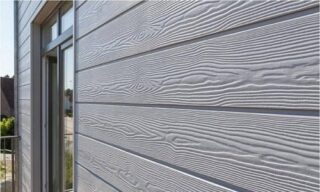
Fiber cement building material contains binding fibers as a filler, cement, mineral particles, pigments. Wall cladding boards (siding), slabs for internal partitions are made from it. Fiber cement siding is one of the types of modern facade cladding, pressed from fiber cement under the influence of pressure in a high temperature mode.
Fiber cement siding has the following characteristics:
- the length of the slabs is 3.0 m, 3.6 m, the size in width is 18.6, 19, 20 mm;
- the thickness of the panels is 8 - 12 mm;
- the weight of one product is about 11.2 - 16 kg;
- ultimate bending strength is 30 MN / m2, compressive strength - 90 MN / m2;
- water absorption 20%;
- the number of frosts and thaws that the material can withstand without deformation - 150;
- belongs to the low flammability category - G1.
Moisture resistance and reliability are provided by cement, and fibrous particles give elasticity, flexibility, and increase bending strength. Fiber fibers reduce the expansion of the material with temperature changes, and perform the function of additional reinforcement inside the panels.
Areas of use for fiber cement siding
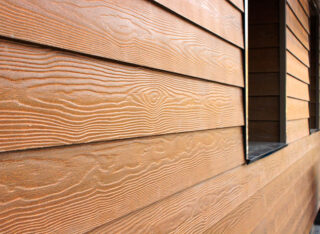
Fiber cement boards are used in construction without restrictions, cement siding with filler is suitable for finishing private, public, industrial and military buildings. The material works successfully in various climates, does not deteriorate when exposed to an aggressive environment.
Scope of application:
- decoration of external walls of buildings without an insulating layer;
- finishing device like a hinged facade with the installation of insulation from cold, waterproofing, vapor barrier;
- filling the spans between fence posts;
- installation as a cladding inside rooms with high humidity, for example, in swimming pools;
- sheathing of frame buildings for gazebos, verandas, various pavilions, bus stops.
Suspended facades are made on a frame made of wood or galvanized profiles. Cement fiber siding trim is allowed to be used in children's institutions, hospitals, dispensaries. The material belongs to the group of environmentally friendly finishes.
Advantages and disadvantages of the material
When heated by the sun's rays, the material does not emit harmful components into the ambient air, therefore its use is safe for health.
Benefits of cement and fiber siding:
- durable panels last about 50 years, while the original color remains for 15 years, after which a gradual fading from ultraviolet radiation begins;
- the material is not afraid of severe frosts and summer heat;
- dust, dirt does not accumulate on the surface;
- fiber cement is not destroyed by water, corrosion, does not rot;
- the flammability of the finishing layer is zero;
- looks good next to other types of building materials;
- the consumption for heating the house is reduced.
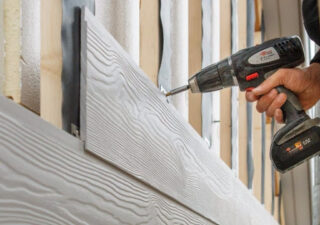
Installation of fiber-cement boards is carried out in the same way as other types of siding on the crate, so this method is common and simple. You can do it yourself without involving specialists.
In the basic version, cement siding is inexpensive, but after installation, the surface must be treated with paint and varnish, which will increase the cost of the cladding. Fiber cement has an impressive weight, so when finishing an existing building, you need to strengthen the foundation.
Care must be taken when transporting, as long panels are fragile and can crack if not carefully stored.
It will not work to saw the products by hand; you need to use an electric tool. It is difficult to screw self-tapping screws into the material, therefore, holes are pre-drilled 0.5 mm less than the diameter of the hardware.
Varieties of fibrosiding
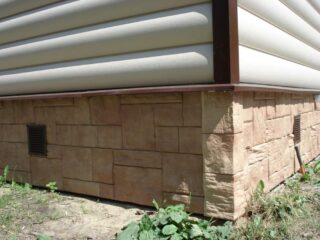
Differences between individual types of products are due to the use of different types of fillers, mineral components and manufacturing technologies. Fiber cement cannot be considered a new material, since the first products were produced at the end of the 19th century in Austria.
Varieties of cement siding:
- asbestos-cement panels;
- polyamide-cement boards;
- cement-bonded products;
- porous variety based on different fillers.
Manufacturers have almost completely abandoned asbestos-cement types, since such fibers are harmful to health. Natural basalt, aramid, cellulose filamentary particles are used in modern products. The fibers are safe for humans, do not reduce the quality characteristics of fiber cement.
Cement-based chipboard differs from fiberglass in that it is unstable in humid conditions. The wood in the composition absorbs moisture and gradually collapses. They are rarely used because there is a more practical alternative.
Porous panels are produced by extrusion, while air cavities are formed inside the material, a uniform spongy structure is obtained. The technology is used to reduce weight, increase heat-shielding properties.
Textures and sizes
Fiber cement boards are produced with a smooth and textured surface. Panels with imitation of different materials are in demand, for example, fiber cement siding for brick, stone, wood, leather. The Cedral model is produced, which conveys the pattern and texture of cedar wood. The homogeneous structure serves as a good medium for textured embossing, so all kinds of decorative boards look realistic.
Fiber cement is used to produce finishes:
- long boards imitating various materials in the form of siding panels with a longitudinal clamp along the edge to grip the elements;
- finishing wide slabs for various purposes, smooth and textured.
Wall and basement siding can be used as intended. The second type is characterized by greater strength, thickness and weight. The material is impregnated with agents that completely repel moisture, since the base is located immediately above the soil. Porous types are not used for the basement of the house.
Production technology
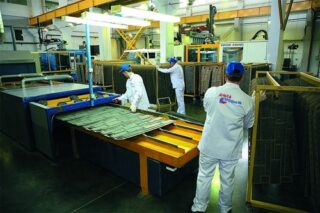
First, the raw materials are prepared. The sand is crushed, the cement is processed, the type of fiber is selected. The components are mixed in large containers, water is added.
The following production steps:
- Fiber cement mortar is formed in the form of a layered workpiece, dried, cut into separate panels of equal size. They are piled up for later use.
- Residual moisture is removed from the body of the semi-finished product by pressing, the material is compacted and hardened. A pressure of 65 atm is used. For smooth panels, standard pressing is used, and the textured surface is made by pressing (extrusion) to give the board shape and texture.
- The pre-setting stage takes 6 - 8 hours, the panels are kept in heat and humidity chambers.
The final processing takes place in autoclaves, where the products are hardened under steam at + 175 ° C and a pressure of 10 atm. After that, inspectors identify defects, make technical measurements to determine unacceptable deviations in quality and dimensions.
DIY making
Suitable shapes are selected for the production of panels. Wooden boards, chipboard panels will not work, since they will absorb water from the solution. This will lead to a decrease in strength, since the cement will harden in an abnormal environment. It is good to use plastic molds, and if they are not there, then OSB boards, which are saturated with wax during the production process, and do not draw in water, are suitable.
Manufacturing rules:
- Before pouring the plates, fasteners are provided, the dimensions for which the stands are made inside the formwork and the pins are installed, this is done in order to subsequently reduce the number of drills in the cement board.
- Prepare a cement-sand mortar with a concentration of 1: 4 (cement, sand, respectively) and cellulose fibers.
- The fiber is mixed with the solution, the mass is poured into a mold, and left to set for several days.
Pulp can be purchased at hardware stores, ordered online. For the solution, it is better to take cement M400, quarry sand. After pouring, the surface of the slab must be covered with cellophane.
Installation, docking methods
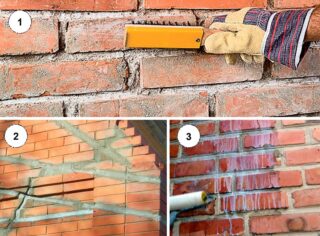
Before finishing, you need to remove the peeling plaster on the walls, open up the cracks. To do this, the crevice is deepened with a knife, then primed and sealed with repair mortar. If, during the installation of the frame, a dowel gets into the untreated slot, over time it will loosen and the finishing layer will begin to vibrate.
To fix the cement siding, a crate is placed. Wooden bars are rarely placed under heavy panels, more often they use galvanized metal profiles from a g / cardboard system. Wooden slats are treated with antiseptics against decay, fire retardants against fire. Mineral wool is applied to the wall before installing the uprights. Foam insulation is installed between the frame elements, then the resulting cracks are blown out with foam.
There are two methods for installing siding:
- overlap;
- end-to-end.
Provide for hydro and vapor barrier in the form of a film membrane. For mineral wool, a counter-lattice is made so that there is a ventilated gap where the condensate will dry. The lumen is made so that fresh air can be accessed from above and below the layer.
Overlapping installation
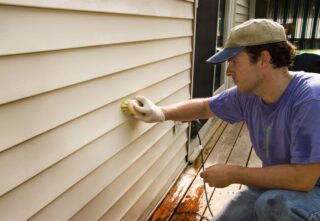
The structure of the lathing is made of a CD - 60 metal profile; ES canopies are used for fixing. The fastening step is made 60 cm between the vertical elements. A horizontal bar is made at the bottom for attaching the starting bar. The groove in it should not be narrower than the thickness of the first row siding panel.
The sheathing is installed at an angle so that the bottom overlaps the start, hanging over it. Subsequent stripes overlap the previous panel. The first board is fixed with self-tapping screws to the support rail, and the subsequent ones are fastened with nails at a distance of 20 mm from the edge of the siding panel. If the technology is observed, the attachment points are not visible, and the whole wall surface is obtained.
Butt assembly
The method is only suitable for a type of fiber siding that has a lock along the entire perimeter of the strips or only on one edge of the boards. The first sheathing is installed similarly to the overlap option on the crate frame and fastened to the horizontal bottom rail with self-tapping screws.
Vertical racks are installed under the horizontal panels with a step equal to the panel length. Slabs are joined only on the racks of the crate. If the panels do not have clips around the perimeter, but only on one side, a connecting strip is used to join them. It is installed on a frame rack, fastened with self-tapping screws with a galvanized coating. The joint is sealed with a sealant so that the edge does not collapse over time.
Fiber Cement Siding Care
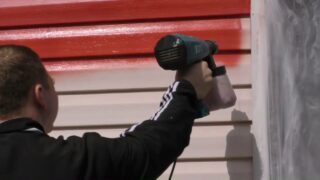
Dirt does not accumulate on the surface of the cement siding, but if dust is found, a soapy water solution should be used. Rainy weather helps cleaning, but maintenance should be done once a year, it is better to do this in autumn and spring. The panels should be inspected for the first time 6 months after installation.
Cleaning methods are used:
- a hose with water to wash off minor traces of dirt;
- soft sponges, brushes and cloth for cleaning walls;
- suitable detergents without abrasive particles.
To increase the attractiveness, gray cement panels of a simple pattern are painted and varnished. Oil, pentaphthalic, latex and acrylic paints with appropriate pigments are used.








